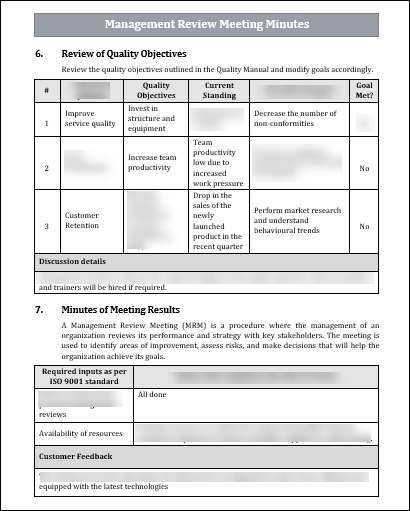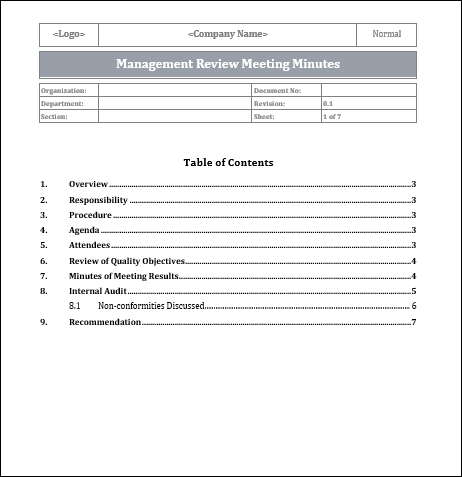ISO 9001 Management Review Meeting Template
An ISO 9001 management review meeting template is a valuable tool that organizations can use to conduct productive and effective management review meetings as part of their quality management system. The purpose of these meetings is to evaluate the performance of the organization against the requirements of the ISO 9001 standard, identify areas for improvement, and make informed decisions about the organization's quality objectives and strategies.
The template provides a structure for the meeting, including an agenda, a list of required inputs and outputs, and a format for documenting the meeting minutes. By using this template, organizations can ensure that their management review meetings are focused, productive, and consistent, helping them to continually improve their quality management system and meet the needs of their customers.
The Importance and purpose of management review meetings in ISO 9001
- Enhancing overall performance: Management review meetings provide an opportunity for top management to evaluate the effectiveness of the quality management system (QMS) and identify areas for improvement. These meetings help in ensuring that the QMS is aligned with the organization's strategic objectives and is delivering the desired outcomes.
- Ensuring compliance: ISO 9001 requires regular management review meetings to assess the implementation and effectiveness of the QMS. These meetings enable top management to review compliance with legal and regulatory requirements, customer expectations, and internal policies.
- Continuous improvement: Management review meetings play a crucial role in driving continuous improvement within the organization. It allows top management to review quality objectives, key performance indicators (KPIs), and organizational processes to identify opportunities for improvement and take corrective actions where necessary.
- Resource allocation: These meetings help in allocating resources effectively to address identified issues and achieve the desired outcomes. It provides an avenue for top management to review resource availability, allocation, and utilization to ensure that the necessary resources are allocated to support the QMS effectively.
- Communication and employee engagement: Management review meetings facilitate communication between top management and other key stakeholders, including employees. It provides an opportunity for sharing information, discussing concerns, and soliciting input from the relevant parties. This engagement helps in creating a culture of quality consciousness and involvement at all levels of the organization.
- Reviewing policy and objectives: ISO 9001 requires top management to review the organization's quality policy and objectives regularly. Management review meetings provide a platform to assess the relevance and alignment of the policy and objectives with the organization's strategic direction and customer requirements.
- Risk assessment and mitigation: Management review meetings enable top management to review and assess risks and opportunities associated with the QMS. This includes evaluating the effectiveness of risk mitigation measures, identifying emerging risks, and taking proactive steps to mitigate them.
Key components of an effective ISO 9001 management review meeting template
- Meeting agenda: A well-structured agenda is essential for a productive management review meeting. It should include key discussion points such as reviewing the company's quality objectives, monitoring performance against metrics, identifying areas for improvement, and addressing any non-conformance issues.
- Attendees: The template should specify who should attend the management review meeting to ensure all necessary stakeholders are present. This typically includes senior management, quality managers, process owners, and representatives from relevant departments.
- Review of previous minutes: The template should have a section to review the minutes from the previous management review meeting. This allows for follow-up on any outstanding actions or decisions that were made.
- Performance metrics and objectives: The template should provide space to analyze the company's performance against previously set quality objectives and metrics. This can include reviewing customer satisfaction surveys, on-time delivery rates, scrap rates, and any other relevant performance indicators.
- Non-conformance and corrective actions: A section should be dedicated to addressing any non-conformances or issues identified through audits, customer feedback, or other means. This allows for tracking the implementation of corrective actions and monitoring their effectiveness.
- Risk assessment: The template should include a discussion on risk assessment and management, including potential risks to achieving quality objectives and the effectiveness of risk mitigation strategies.
- Review of resources: This section should address whether the company has adequate resources, including personnel, training, and equipment, to meet quality objectives and the requirements of the ISO 9001 standard.
- Continuous improvement: The template should prompt a discussion on opportunities for improvement. This can include soliciting suggestions from attendees and brainstorming potential process changes or innovations that could enhance the company's quality management system.
- Follow-up actions: It is important to have a section to record any decisions or actions that need to be taken as a result of the management review meeting. These actions should be assigned to specific individuals or departments and have clear deadlines for completion.
- Review schedule: Finally, the template should include a schedule for future management review meetings to ensure regular and consistent review of the company's quality management system.

The Benefits of using a standardized template for management review meetings
- Consistency: By using a standardized template, organizations can ensure that all management review meetings follow a consistent format. This allows for easier comparison and analysis of meeting outcomes and discussions across different time periods and departments within the organization.
- Time-saving: Having a standardized template streamlines the process of preparing for management review meetings. The template serves as a guide and prompts the necessary information to be included, reducing the time spent on deciding what to include and how to structure the meeting.
- Comprehensive: A standardized template ensures that all important aspects of ISO 9001 management review are covered. It helps ensure that discussions include key elements such as the status of quality objectives, customer feedback, non-conformance and corrective actions, internal audits, and any required changes to the quality management system.
- Improved organization and record-keeping: Using a standardized template makes it easier to keep track of past and upcoming management review meetings. It allows for consistent documentation of meeting minutes, which can be helpful for referencing and review purposes in the future.
- Facilitates decision-making: A standardized template provides a clear structure for discussing management review topics. This facilitates decision-making by ensuring that relevant information is presented in a systematic manner, allowing for better analysis and evaluation of the organization's performance.
- Compliance with ISO 9001 requirements: ISO 9001 requires organizations to conduct regular management review meetings. Using a standardized template helps ensure that these meetings meet the requirements of the standard, making it easier for organizations to demonstrate compliance during audits.
- Increased accountability: A standardized template can help define roles and responsibilities for different participants in the management review meeting. This helps establish accountability and ensures that relevant personnel are aware of their responsibilities in providing necessary information and participating in the meeting.
Overall, using a standardized template for ISO 9001 management review meetings brings consistency, time-saving, comprehensive documentation, improved organization, better decision-making, compliance, and increased accountability to the process.
Conclusion
In conclusion, using an ISO 9001 Management Review Meeting template can greatly benefit an organization. It provides a structured approach to reviewing quality management systems and ensures that all relevant information is discussed and evaluated. This template helps to identify areas for improvement, set objectives, and ensure that processes are meeting the requirements of ISO 9001. By using this template, organizations can ensure that their management review meetings are efficient, effective, and contribute to the continual improvement of their quality management systems.




